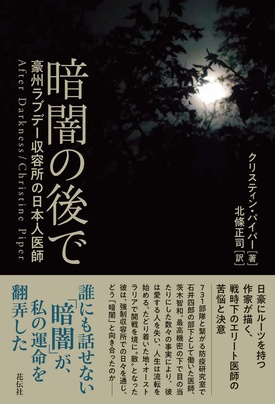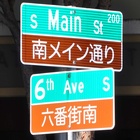Detention Centers, Institutions for Disease Control, and Wavering Feelings
It is well known that at the start of the Pacific War, Japanese and Japanese-Americans in the United States were deemed "enemy aliens" and isolated in internment camps, but what is less known is that similar internment camps also existed in Australia.
During World War II, Australia was an enemy of Japan as it was part of the Allied Powers, and the Japanese military attacked Darwin on the Australian mainland, among other things. As mentioned in a previous column , at the time, there were Japanese people from Wakayama Prefecture who had traveled to Australia since the Meiji period to harvest pearl oysters (white-lipped pearl oysters), and Japanese people who worked in the sugar cane industry there.
When the war began, they and other Japanese living in Australia at the time were sent to internment camps. With this historical background, the Japanese version of the novel "After Darkness" (published in Australia in 2014) was published in Australia in August this year as "After Darkness: The Japanese Doctor at Loveday Internment Camp in Australia" (Kadensha). There are many similar fiction and non-fiction works in the United States, but it is rare to see a novel set primarily in Australia.
The author, Christine Piper, is an Australian author and journalist who was born in Korea in 1979 to a Japanese mother and an Australian father, and moved to Australia at the age of one.
This is her debut novel, and she won the Vogel Prize for new writers in Australia. She is also a promising young author whose work was shortlisted for the Miles Franklin Prize, Australia's most prestigious literary award. She has also published a highly acclaimed non-fiction essay, Unearthing the Past, about wartime issues in Japan, as a journalist.
With roots in Japan and Australia and a journalistic perspective, "After Darkness" is based on historical facts from the war between Japan and Australia, and depicts the human drama of people surviving the turbulent times from the naive perspective of a Japanese doctor.
Traveling through time between the three capital cities
The story begins in Australia at the Loveday internment camp in 1942, just after the outbreak of war. This was one of three camps actually set up by Australia to isolate enemy aliens, and was located in South Australia.
The protagonist, a Japanese doctor named Ibaraki Tomokazu, had been working as a doctor in the Japanese community of Broome in the northwest of Australia, but when the war began he was sent to the Loveday internment camp.
The camp is guarded by soldiers with guns, and the inmates have limited freedom. There are other Japanese people living in Australia, but there are also a few "Japanese" people who were born in Australia and are of other descent than Japanese. They do not get along with the Japanese, and trouble breaks out in the camp, and one young Japanese man is seriously injured and near death, and becomes mentally ill.
At first, Ibaraki believed what the Japanese leaders in the camp said and did not sympathize with the young Japanese people, but he gradually began to sympathize with and understand them.
The story then shifts from Ibaraki's life as a doctor in the camp to Tokyo in 1934. Ibaraki had begun his training at Tokyo Imperial University Hospital to become a doctor, but he felt powerless when confronted with patients and lost confidence in his ability to become a doctor. At that time, he was invited to work as a researcher in the medical research department of the Army Medical School.
After this, the story flashes back to the Loveday camp, then goes back a little in time to Broome in 1938. The story depicts the Japanese town and the Japanese community, and begins Ibaraki's work at the Japanese hospital, where he meets Bernice, a nun and nurse at the local convent who assists him in his treatment.
Thus, the story progresses back and forth in time between three locations: Tokyo, Loveday Prison Camp, and the Japanese Hospital in Broome, and in the process, the path of Dr. Ibaraki's journey from Tokyo to Australia becomes clear like a puzzle.
Ibaraki becomes a researcher at the Institute for Epidemic Prevention established at the Army Medical School in Shinjuku, but the research he undertakes there is part of a biological weapon development project involving the Kwantung Army Epidemic Prevention and Water Supply Department. He has already married the woman of his dreams and started a family, but as he is busy and worried about his research, a rift forms between the couple, and eventually a critical problem arises, causing his wife to leave him.
Meanwhile, so-called human experiments are also conducted in the research, and Ibaraki begins to help with them, but eventually he can no longer bear it and is fired as a researcher. Having lost his wife and his job, Ibaraki is at a loss as to what to do, and when he finds out that there is a job as a doctor in the Japanese town in Australia, he heads to the town of Broome as an escape.
Eventually, the war breaks out and he is interned, but he is able to board an "exchange ship" that exchanges prisoners and prisoners between Japan and the Allied Powers, and returns to Japan. He is reunited with his wife and they come to understand each other, but... Time moves on, and the story ends with Ibaraki's recollections of 1989 and a certain resolve to face the horrible truth he was once involved in.
Scattered facts
Through the events involving the protagonist, Dr. Ibaraki, the story highlights the negative aspects of wartime, such as biological weapons, human experiments, "racial" conflicts in the camps, and the shooting of prisoners, but the events unfold in a thrilling and mysterious way at times. Furthermore, romance is woven in, adding color to the overall gray story.
Apart from the storyline, the historical facts that form the basis of the film are also interesting. For example, many of the Japanese and Japanese-Americans who were interned were Japanese divers who were in Australia at the time harvesting pearl oysters, and Japanese people who were in French New Caledonia were also forcibly deported. Furthermore, Taiwanese people who were under Japanese rule at the time were also interned.
Other points to note are that the position of Japanese Americans was different from that of their American counterparts during the war, such as the exchange ships that took place between the United States and Japan, and Australia also exchanging prisoners and internees with Japan at the port of Lourenço Marques in East Africa.
The translator, Hojo Masashi, is a PhD in science specializing in chemistry, but his father went to Broome, one of the settings in this book, before the war and worked as a diver harvesting pearl oysters, and he was interned after the outbreak of the war, so he has been collecting materials related to the theme of this book.
When the author heard about this, he paid a visit to Hojo to learn more about the book. Hojo was sent a copy of the book, and at one point "he became obsessed with the idea that he was the only one who could translate the book into Japanese and send it out to the world, and so he came up with the idea of translating and publishing it."
© 2023 Ryusuke Kawai







